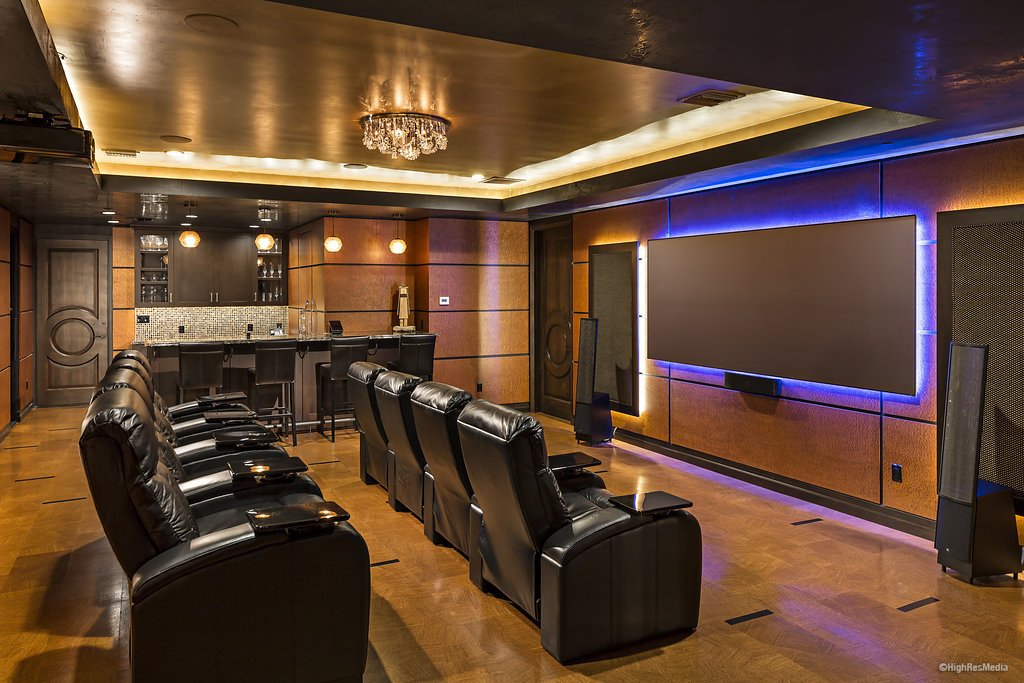In-Home Theater
With so many entertainment options at our fingertips, installing an in-home theater has become a more common and attractive concept. Additionally, advances in technology and affordability have made an amenity once reserved for the wealthy available to the masses. There is a wide variety of equipment in all different price points that allow for a range of in-home theaters from an entry-level budget to a more extravagant system. If you are a looking to create a dedicated home theater, there are many factors to consider including the budget, room size, layout, and equipment.
The room size and budget will help dictate the equipment you purchase, which will then dictate the room configuration. This is why the equipment and specs should be finalized before you layout your theater. When deciding what room to install your home theater, the shape of the room can play an important role in the user experience. For example, the rectangular shaped room is generally better than a square room from an acoustical point of view. Additionally, a room without windows is much better than a room with windows, although advances in window coverings can help solve this dilemma. The window coverings can be used to block out light to create that theater ambiance. In designing the room, think of your local movie theater and try to mimic the design elements and types of finishes. If possible, you will want surfaces that absorb rather than reflect sound. Avoid a room with wood or tile flooring and instead opt for carpet, preferably a plush carpet with nice padding. Walls that are simply drywall can be used in your home theater. However, if your budget permits, you may want to consider installing acoustic tiles/boards on the walls and wrap them in a padded fabric or even place carpet over the top. When it comes to lighting and colors, it is best to avoid anything that distracts from the immersive experience of the in-home theater. Painting the ceiling black is a good choice and walls should also be dark or subtle colors. Lighting should be adjustable so that while viewing all lights can be turned off except for some low-level wall lighting.
Of course, even the best-designed room will not provide a great experience without the right equipment. Probably the most important element of your home theater is the viewing screen. There are essentially two choices when it comes to screens, flat-panel HDTVs or HD projectors. Advances in HDTV technology has resulted in much larger screens being available and 75-inch and larger screens are becoming more common. HDTVs larger than 75 inches become expensive and cost-prohibitive for many people. If you want a large 100 plus inch screen, your best bet is an HD projector. A quality HD projector is more affordable than ever. Of course, if you choose a projector, you will also need a quality screen. Depending on the size and the design you are going for, screens can drop down from above or can be mounted on a wall. If mounting on a wall, many people chose to frame their screen for a more polished look. There are many different audio options for home theaters. If you are looking for simplicity, then you may choose a single soundbar or a sound bar paired with a subwoofer and/or surround speakers. A simple soundbar system can be very economical and provide some surprisingly good sound. However, if you are looking for the true movie theater experience, a true surround sound system is a must. This type of system consists of a dedicated AV receiver and speakers. You will want at least a 5.1 channel surround sound system, which includes three speakers in the front of the room, two rear surround speakers, and a subwoofer. In 7.1 channel systems, which are becoming much more common, there are two additional surround speakers. Now that you have your viewing screen and audio systems figured out, you need video sources for your content. There are more ways to watch content today than ever before. The most familiar sources are your cable or satellite service and a Blu-ray player. One of the more recent advancements is the move towards more digital content versus physical media. Media streaming devices and services have made a wide array of content available at the touch of a button. Besides streaming devices, home theater PCs are a way to store and view digital content. When choosing your audio and video equipment, just make sure it is able to handle all of your different sources of content.
A home theater is a great addition to any home. They are great spaces for entertaining guests, family nights, or a place to unwind.


